I tried to stretch the frame using sticky='nsew' but it's not working properly. I have attached the screenshot here.
the white color window is my frame and i want to stick to all corners. i dont wanna mess up with the buttons that i made. its working if i set row=0 but in that case i lost the buttons.. i wanna keep that button too
from tkinter import *
root=Tk()
root.title("manage your cashflow")
#for setting full screen window
screen_width=root.winfo_screenwidth()
screen_height=root.winfo_screenheight()
print(screen_height, screen_width)
root.geometry("%dx%d" % (screen_width,screen_height))
root.configure(bg='grey')
#configure
Grid.rowconfigure(root,0,weight=1)
Grid.columnconfigure(root,0,weight=1)
Grid.columnconfigure(root,1,weight=1)
# creating tabs
up_button1= Button(root, text="the list of month", bg='#ebca87')
up_button1.grid(row=0,column=0, sticky='NEW')
up_button2=Button(root, text="the new month",bg='#ebca87')
up_button2.grid(row=0,column=1,sticky='NEW',pady=0)
#class for frames
class frame:
#method for
def frame2(self):
#for frame sticky
Grid.rowconfigure(root,1,weight=1)
Grid.columnconfigure(root,0,weight=1)
Grid.columnconfigure(root,1,weight=1)
#frame for listbox
frame2=Frame(root)
frame2.grid(row=1,column=0,columnspan=2,sticky="NSEW")
Grid.rowconfigure(frame2,0,weight=1)
Grid.columnconfigure(frame2,0,weight=1)
Grid.columnconfigure(frame2,1,weight=1)
salary_text=Label(frame2,text="salary")
salary_text.pack()
salary_entry=Entry(frame2)
salary_entry.pack()
frame_ob=frame()
frame_ob.frame2()
root.mainloop()
I want to stretch the frame to the buttons. how do I do it? you guys can see in the screenshot that the white frame doesn't stick to all corners of the 2nd row and 1st and 2 column
